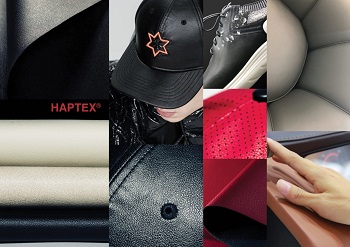BASF today launched 10 variations of Haptex 2.0 – a new and improved series of its innovative polyurethane (PU) solution for the production of synthetic leather. Enhanced with a higher peel strength, anti-yellowing, and high abrasion performance properties, Haptex 2.0 enables designers to achieve high performance and the desired appearance of applications using synthetic leather across different industries, such as furniture, footwear, automotive, apparel, and accessories. Additionally, without using any organic solvents, synthetic leather made with Haptex 2.0 meets stringent VOC standards.
“Today, we present this iconic PU solution offering enhanced functionalities to the market. With Haptex 2.0, we are pushing the boundaries of creative design, and combining style with high performance for various applications,” said Manfred Pawlowski, Vice President, Consumer Industry, Performance Materials Asia Pacific, BASF. “Haptex synthetic leather redefines the limits of design freedom and scores a point for sustainability: zero solvents and low levels of emission combined with top production efficiency to make our customers more competitive.”
The furniture industry has seen a resurgence in the demand for high-quality and eco-conscious leather furniture. The combination of soft-touch and high peeling strength of Haptex 2.0, compared to industry standards, will help furniture makers to meet the demand for design freedom and durability in the luxury high-end furniture market.
Being light, flexible, and chemical resistant, Haptex is the perfect material for consumer electronic accessories, such as mobile phone covers. The leather has gone through stringent heat soak testing under conditions of 65ºC and 90% relative humidity for 72 hours with eight different solutions – sunscreen, sweat particles, olive oil, hand cream, sebum, oleic acid, insecticide, and perfume. Haptex is proven to be chemical resistant to these commonly used liquids, which results in better protection for mobile devices.
Leather for the footwear and fashion industry must be adaptable to allow a range of material treatments that result in textured and tumbled finishes for different designs. Thanks to Haptex 2.0, the highly versatile material can meet these requirements as well as satisfy the growing customer demand for sustainable leather. Apparel and fashion accessories, such as belts and bags, made of Haptex 2.0 leather, have a soft and supple feel, bringing comfort and fashion together. Its new high adhesive base also enables long-lasting footwear.
Automotive brands are always looking for materials that improve passenger and driver comfort and experience. Synthetic leather made without organic solvents helps reduce emissions and thus odors, thereby improving the interior air quality of cars. With its excellent and soft-touch haptics, Haptex 2.0 also helps enhance the look and feel of seatings. Additionally, with its improved anti-yellowing, abrasion resistance, resistance to flex cracking, and ability to withstand a broad range of weather conditions, including temperatures down to minus 30 degrees celsius, Haptex 2.0 helps automotive makers meet the demand for more durable automobile interiors.
